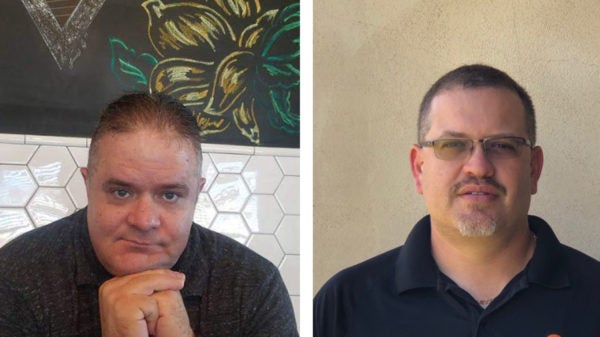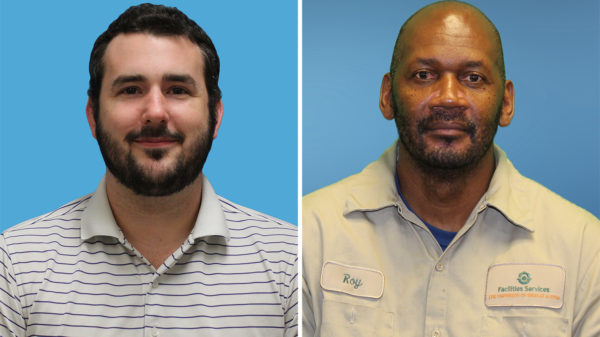On the afternoon of March 17, a few days into spring break at The University of Texas at Austin, Faith Miller received an email while working at her job as San Jacinto Residence Hall’s complex coordinator.
The email included campus correspondence from then UT President Gregory L. Fenves and detailed significant developments in the university’s response to COVID-19: Classes would move online for the rest of the semester, and students were required to move out of residence halls. Students would be allowed to return only to move items out between March 30 and May 20.
Miller, who oversees everything going on in San Jac, says leadership from within Housing and Dining and across the university had been working on potential scenarios, but the email, which she says she received at the same time as students living in her residence hall did, made things official. That’s when “things kicked into high gear,” she says.
“As soon as that email went out, our desk got flooded with calls about, you know, ‘When can I come? Can I come now?’” Miller says. “If students weren’t calling our front desk, they were contacting their RAs about, ‘What’s going on? What’s happening?’”
Miller was among the UT staff and faculty members who continued to work in March during spring break as the university responded to COVID-19. Even after campus had settled into its post-break state — in which students had switched to remote learning for the rest of the semester and many university employees had started working from home — some staff and faculty members continued to work on campus.
After the email came in, Miller had to quickly instruct her desk staff and resident assistants about how to respond to students who needed to move out or retrieve their things. She says their aim was to be a hub of support and information.
“I worked really closely with my assistant complex coordinator, Haile (Duplantier), to formulate messaging for our student staff to be able to communicate to their residents,” Miller says.
While helping students move out, Miller also oversaw students moving into San Jac, which was the only hall on campus open to provide emergency housing. She worked alongside Duplantier and her administrative assistant Alice Clayton to manage the moves and to maintain health and safety in ways such as making sure the desk staff and residents had cleaning supplies.

STAYING HEALTHY
During spring break, Robert Reed was also dealing with a challenge: setting up staff members at University Health Services and the Counseling and Mental Health Center to conduct telehealth services even though no clinician at either organization had done it before.
Reed, the assistant director for UHS and the CMHC health information technology services, is in charge of IT support for both organizations. UHS and the CMHC had been considering telehealth — in which providers use services such as Zoom to see their patients and clients — as an option to extend their services, but when both suddenly needed to make the switch, Reed worked to get university-sanctioned laptops out to providers and help familiarize them with how to do their jobs remotely.
“It’s been about a month to go from not doing it at all to having that being our primary way of seeing our patients,” Reed says. “My team and I, I think we did 10 times as much stuff in the last month than we typically do in a year.”
Reed and his team started by setting up the university’s 60 to 70 counselors, then its roughly 40 medical providers, physician assistants and nurse practitioners. By late April, Reed was finishing setting up physical therapists and was preparing to get nutritionists and dietitians up and running with telehealth.
SORTING IT OUT
Herman Vallejo and Steve Burdette both have continued to work on campus during the pandemic as part of Document Solutions, a campus service that provides printing, copy and mail services to the UT community and Texas state agencies.
Burdette, DocSolutions mail manager, says beginning during break, DocSolutions worked to figure out how to continue supporting campus while some buildings were occupied and others were not. Burdette’s job typically includes responsibilities such as overseeing all incoming U.S. Postal Service mail and packages and the processing of outgoing Postal Service mail and packages.
Burdette developed a master document that included whether buildings were occupied as well as other information, such as which buildings needed packages, supplies and mail picked up and delivered daily and which only wanted them delivered on specific days of the week. He included what hours a building would be occupied, so someone could be present when mail was delivered. For unoccupied departments, he included whom to contact about delivering or holding on to mail.
“The first two weeks were really kind of a scramble for us until we got a process put in place that I think works pretty well right now,” Burdette says.
Burdette shared that document with Vallejo, a supervisor with Campus Distribution. Vallejo oversees the receipt and delivery of hundreds of packages a day to the university. He works in a part of DocSolutions different from Burdette’s and deals with packages delivered by UPS, FedEx and other companies.
After receiving the master document, Vallejo worked to reach out to building managers to coordinate the acceptance of packages. He says during this pandemic, DocSolutions employees have had to adjust how they handle packages and how they interact with people when delivering. Workers making deliveries are wearing masks and gloves. Instead of asking UT employees to sign for their mail, the deliverers have been asking for names and EIDs and doing the writing themselves.

CRUCIAL TO CAMPUS
Tim Dunn and Roy Jones both work under UT Facilities Services, which provides a variety of services such as trash pickup, custodial services, event support services and building operations services.
Dunn, a building automation operator, monitors flood alarms, alarms for heating, ventilation and air conditioning units and other alerts in buildings. His job is to ensure mechanical things are running correctly and coordinate responses to those alarms if needed.
His office has continued to monitor buildings 24/7 and has been able to watch over things that staff members working from home might not be able to keep an eye on themselves.
“A lot of professors, they have really important research that’s tucked away in their buildings,” Dunn says. “Say someone’s researching bacteria, and they’ve got to keep it in a freezer. We can actually see the temperature of that freezer, and if something goes wrong, we see that and we notify the right personnel and just say, ‘Hey, the temperature is set at this amount, but it’s supposed to be at this.’”
Jones, a solid waste supervisor, oversees trash and recycling pickup on campus and sometimes goes out himself. He says usually employees work from 4:30 a.m. to 1 p.m., five days a week. With fewer people on campus and less trash being discarded, pickup has changed to two days a week, he says — Tuesdays and Fridays.
In response to the pandemic, employees picking up trash and recycling use a mask and gloves, and some wear protective body suits. They also have been decreasing the amount of people who are on each truck, instead sending them out in different vehicles.
“We’re just trying to be careful and keep doing our routine,” Jones says. “Every day we’re out there — trying to (provide) service to campus and make sure that we are protected, too.”



